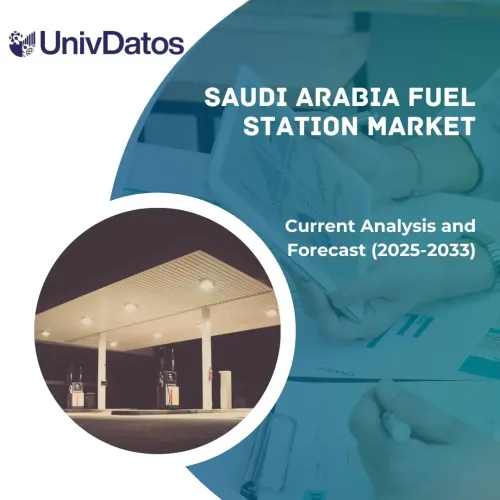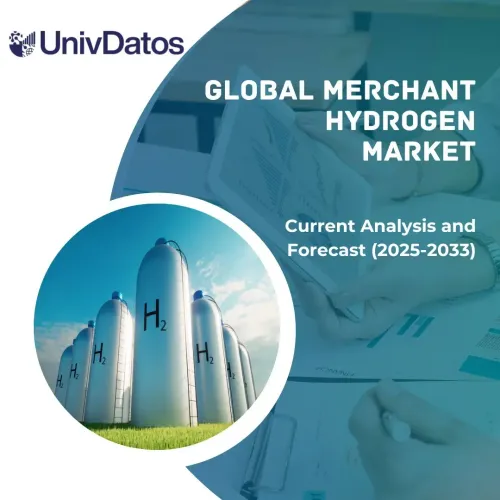- Inicio
- Acerca de nosotros
- Industria
- Servicios
- Leyendo
- Contáctenos
Mercado de motores marinos: análisis actual y pronóstico (2025-2033)
Énfasis en el rango de potencia (>1000 HP, 1001-5000 HP, 5001-10000 HP, 10001-20000 HP y superior a 20000 HP); Tipo (dos tiempos, cuatro tiempos); Motor (motor de propulsión, motor auxiliar), Tipo de embarcación (embarcación comercial, embarcación de apoyo en alta mar, otros; combustibles (fuelóleo pesado, fuelóleo intermedio, gasóleo marino, gasóleo marino, otros); y región y país
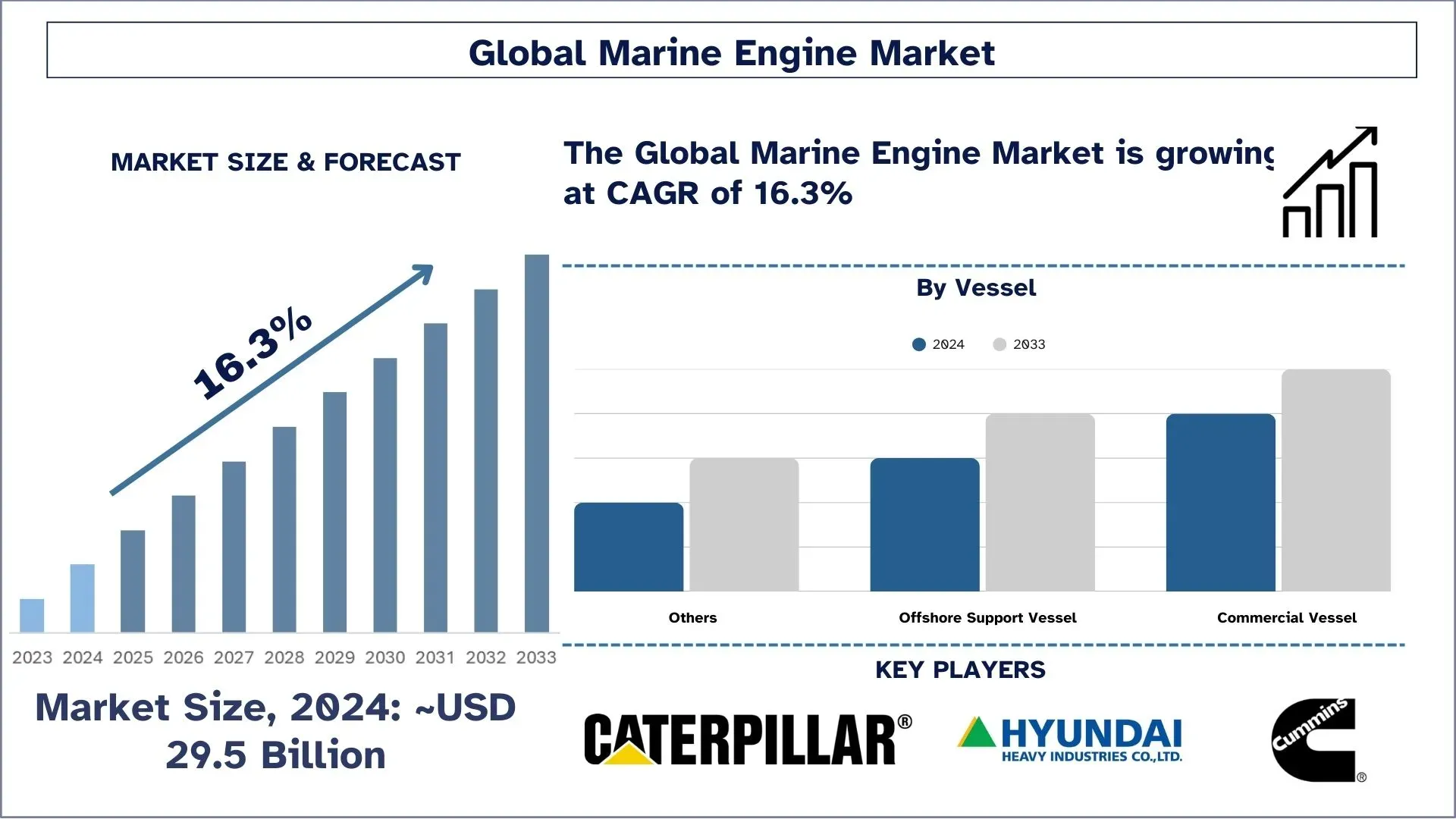
Tamaño y previsión del mercado de motores marinos
El mercado de motores marinos se valoró en aproximadamente USD 29,5 mil millones en 2024 y se espera que crezca a una TCAC sustancial de alrededor del 16,3 % durante el período de pronóstico (2025-2033), debido al creciente comercio marítimo mundial.
Análisis del mercado de motores marinos
El sector del transporte marítimo se considera el pilar del comercio internacional. Según la Cámara Naviera Internacional (Reino Unido), más del 90% del comercio mundial de mercancías en términos de volumen se realiza por mar/océano. El costo del transporte por mar se considera más barato en comparación con el transporte por ferrocarril y por carretera. Asia-Pacífico se considera el principal proveedor de productos manufacturados, por lo tanto, la demanda general de buques portacontenedores es significativamente alta en la región de Asia-Pacífico. Las emisiones de CO2 del sector del transporte marítimo representan el 18% del transporte mundial, con un potencial de calentamiento global equivalente a CO2 a 20 años. Además, el sector tiene como objetivo reducir las emisiones de CO2 en un 50% para 2050, mediante la adopción de nuevos combustibles y motores bajos en carbono y de carbono neto cero. Esto proporcionaría amplias oportunidades de crecimiento para la demanda de biomasa y biocombustibles en la industria del transporte marítimo. Actualmente, la industria naviera mundial consume 300 Mt/año.
Tendencias del mercado de motores marinos
Esta sección analiza las principales tendencias del mercado que influyen en los diversos segmentos del mercado de motores marinos, según lo identificado por nuestros expertos en investigación.
Cambio hacia motores híbridos y de combustible dual
Otra tendencia interesante es el uso de soluciones duales e híbridas en el mercado de tecnología de motores marinos. Estos motores son versátiles y pueden funcionar con combustibles convencionales, como gasóleo marino, GNL, biocombustibles, entre otros. Los avances actuales en ingeniería automotriz, como los que implican el uso de motores eléctricos durante actividades de baja velocidad y motores normalmente alimentados durante la navegación, brindan eficiencia con emisiones reducidas. Esto está en línea con el objetivo del sector marítimo hacia la sostenibilidad, junto con una estricta regulación correspondiente.
Segmentación de la industria del mercado de motores marinos
Esta sección proporciona un análisis de las tendencias clave en cada segmento del informe del mercado mundial de motores marinos, junto con pronósticos a nivel mundial, regional y nacional para 2025-2033.
Se espera que el segmento de más de 20000 HP sea testigo de una TCAC más alta que el mercado de motores marinos.
Según el rango de potencia, el mercado mundial de motores marinos se bifurca en <1000 HP, 1001-5000 HP, 5001-10000 HP, 10001-20000 HP y más de 20000 HP. Actualmente, el motor con un rango de potencia superior a 20000 HP domina el mercado, debido al alto uso en contenedores a granel y otros buques comerciales. Un contenedor a granel está diseñado para almacenar y transportar sustancias líquidas y granuladas a granel, como ingredientes alimentarios, disolventes, productos químicos y productos farmacéuticos, entre otros, en grandes cantidades.
El segmento de buques comerciales tiene la mayor parte del mercado.
Según el tipo de buque, el mercado se segmenta en buques comerciales, buques de apoyo en alta mar y otros. En 2024, el segmento de buques comerciales dominó el mercado y se espera que mantenga su dominio durante todo el período de pronóstico. La alta participación del segmento de buques comerciales se puede atribuir al aumento del comercio internacional de carga y al movimiento de carga, junto con el aumento de la instalación de dispositivos eléctricos avanzados como reemplazo de la infraestructura obsoleta.
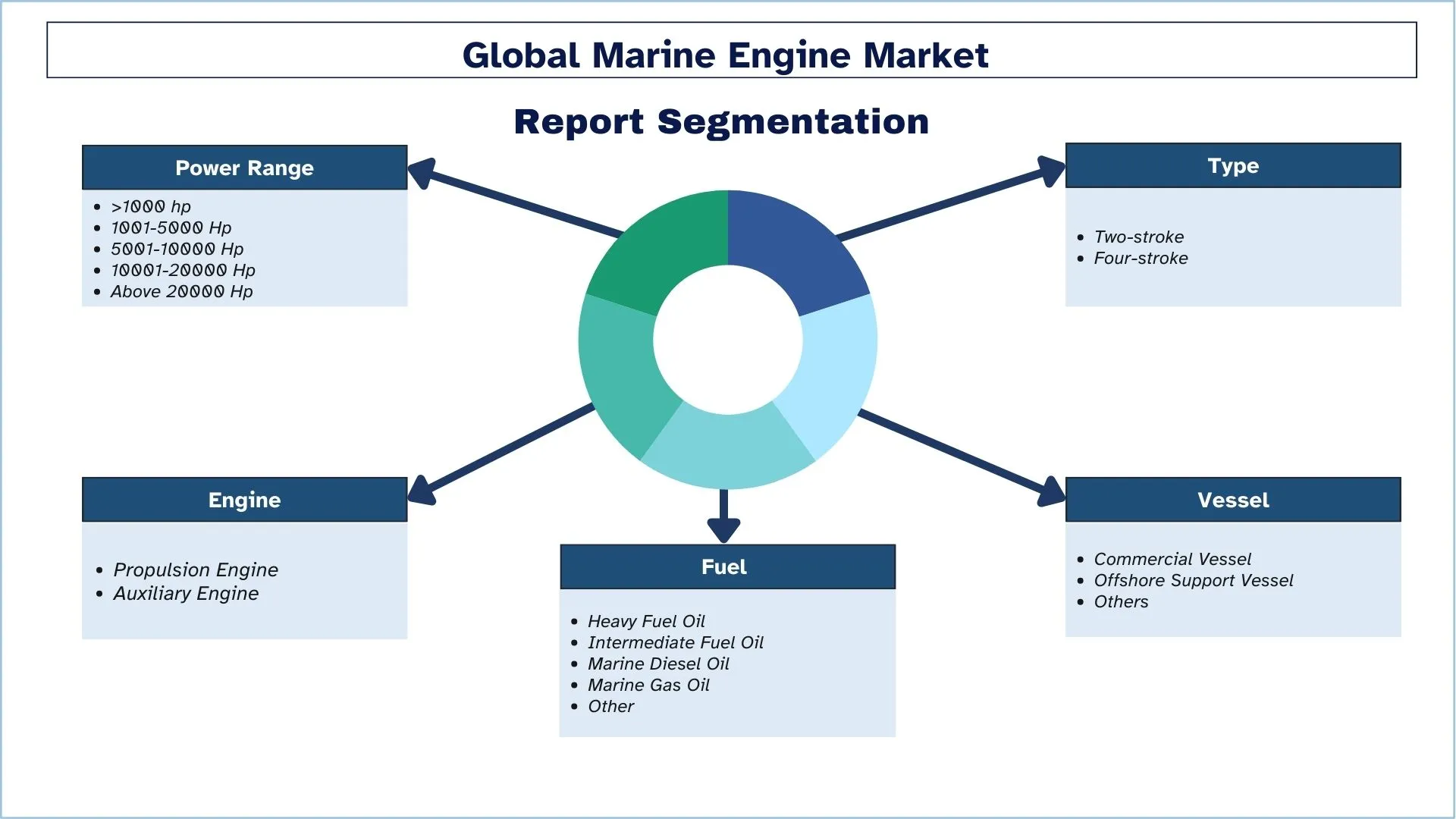
APAC tiene una participación significativa del mercado en 2024.
El mercado mundial de motores marinos está impulsado principalmente por la región de Asia-Pacífico (APAC), ya que es una región geográfica privilegiada en términos de construcción naval y negocios marítimos. Estos países lideran el mercado de la demanda y producción de tales productos, como China, Japón, Corea del Sur e India. APAC también se está moviendo hacia fuentes de energía más limpias, como GNL, motores híbridos y eléctricos, debido a las regulaciones que se están implementando para reducir las emisiones. Este es otro factor amplificado por un capital considerable que se invierte en la mejora de las estructuras marítimas y el avance de la tecnología para la expansión del mercado.
China domina el mercado de motores marinos de APAC
En consecuencia, China es un participante importante del mercado en la fabricación de motores marinos debido a su próspero negocio de construcción naval y las crecientes necesidades de envío locales y en el extranjero. Esto es evidente debido al compromiso del país con una economía "verde", el cambio climático y la reducción de emisiones, lo que fomenta la adopción de motores más limpios, como el GNL y el combustible dual. Además, las crecientes inversiones de China en la mejora de las instalaciones marítimas, junto con la política que impulsa la mejora del grado de eficiencia energética de las organizaciones marítimas, están estimulando el crecimiento del mercado y fortaleciendo la posición de China como líder del mercado.
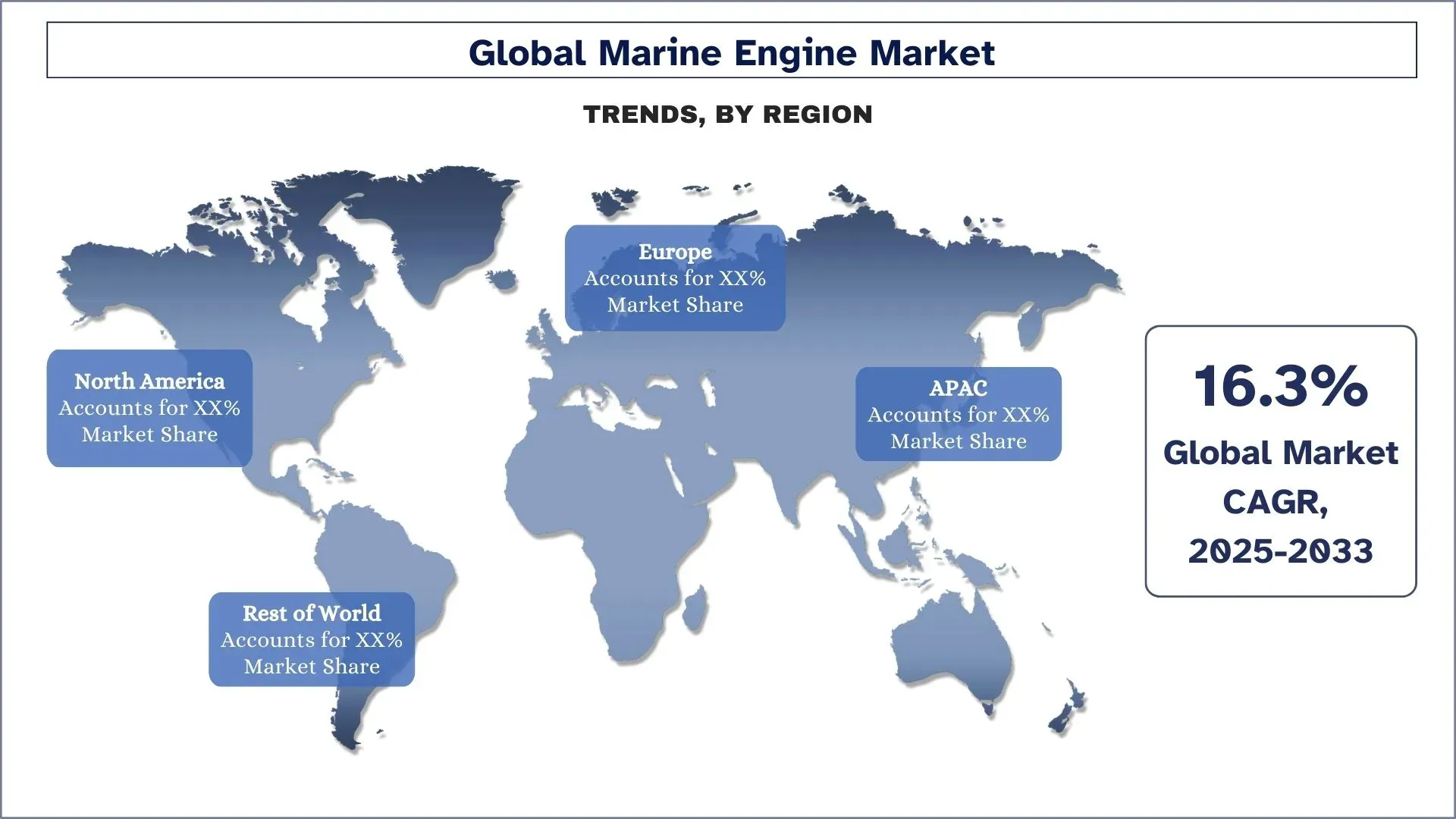
Panorama competitivo de la industria del mercado de motores marinos
El mercado de motores marinos es competitivo, con varios actores globales e internacionales. Los actores clave están adoptando diferentes estrategias de crecimiento para mejorar su presencia en el mercado, como asociaciones, acuerdos, colaboraciones, lanzamientos de nuevos productos, expansiones geográficas y fusiones y adquisiciones.
Principales empresas del mercado de motores marinos
Algunos de los principales actores que operan en el mercado son Cummins, Hyundai Heavy Industries, Caterpillar, MAN SE, Mitsubishi Heavy Industries, Volvo Penta, Rolls-Royce, Win GD, GE Transportation y Deutz AG.
Desarrollos recientes en el mercado de motores marinos
Marzo de 2023: ADT lanzó el último sistema de seguridad para el hogar inteligente de autoconfiguración de ADT, que es una oferta de bricolaje completamente integrada y un sistema de bricolaje mejorado de Google y ADT. El nuevo sistema proporciona un control conveniente de la nueva aplicación ADT+ mediante la integración de los productos para el hogar inteligente Google Nest con las tecnologías de seguridad y protección de la vida de ADT, así como la supervisión SMART.
Febrero de 2023: Costco se asoció con ADT para ofrecer paquetes con un sistema de 13 y 9 piezas, ambos de los cuales incluyen productos Google Nest. La instalación profesional y la supervisión SMART de ADT también forman parte de estos paquetes.
Cobertura del informe del mercado de motores marinos
Atributo del informe | Detalles |
Año base | 2024 |
Período de previsión | 2025-2033 |
Impulso de crecimiento | Acelerar a una TCAC del 16,3% |
Tamaño del mercado 2024 | USD 29,5 mil millones |
Análisis regional | APAC, Europa, Asia-Pacífico, Resto del mundo |
Principal región contribuyente | Se espera que APAC crezca a la TCAC más alta durante el período pronosticado. |
Principales países cubiertos | EE. UU., Canadá, Alemania, Francia, Reino Unido, España, Italia, China, Japón e India |
Cummins, Hyundai Heavy Industries, Caterpillar, MAN SE, Mitsubishi Heavy Industries, Volvo Penta, Rolls-Royce, Win GD, GE Transportation, Deutz AG. | |
Alcance del informe | Tendencias del mercado, impulsores y restricciones; Estimación y previsión de ingresos; Análisis de segmentación; Análisis de la demanda y la oferta; Panorama competitivo; Perfiles de empresas |
Segmentos cubiertos | Por rango de potencia, por tipo, por motor, por buque, por combustible, por región/país |
Razones para comprar el informe del mercado de motores marinos:
El estudio incluye el tamaño del mercado y el análisis de pronóstico validado por expertos clave autenticados de la industria.
El informe presenta una revisión rápida del desempeño general de la industria de un vistazo.
El informe cubre un análisis en profundidad de los pares prominentes de la industria con un enfoque principal en las finanzas comerciales clave, las carteras de productos, las estrategias de expansión y los desarrollos recientes.
Examen detallado de los impulsores, las restricciones, las tendencias clave y las oportunidades que prevalecen en la industria.
El estudio cubre de manera integral el mercado en diferentes segmentos.
Análisis profundo a nivel regional de la industria.
Opciones de personalización:
El mercado mundial de motores marinos se puede personalizar aún más según los requisitos o cualquier otro segmento del mercado. Además de esto, UnivDatos entiende que puede tener sus propias necesidades comerciales; por lo tanto, no dude en contactarnos para obtener un informe que se adapte completamente a sus requisitos.
Tabla de contenido
Metodología de Investigación para el Análisis del Mercado de Motores Marinos (2023-2033)
Analizamos el mercado histórico, estimamos el mercado actual y pronosticamos el mercado futuro del Mercado global de motores marinos para evaluar su aplicación en las principales regiones del mundo. Realizamos una exhaustiva investigación secundaria para recopilar datos históricos del mercado y estimar el tamaño actual del mercado. Para validar estos conocimientos, revisamos cuidadosamente numerosos hallazgos y supuestos. Además, realizamos entrevistas primarias en profundidad con expertos de la industria en toda la cadena de valor del Mercado de motores marinos. Después de validar las cifras del mercado a través de estas entrevistas, utilizamos enfoques de arriba hacia abajo y de abajo hacia arriba para pronosticar el tamaño general del mercado. Luego empleamos métodos de desglose del mercado y triangulación de datos para estimar y analizar el tamaño del mercado de los segmentos y subsegmentos de la industria.
Ingeniería de Mercado
Empleamos técnicas de triangulación de datos para finalizar la estimación general del mercado y derivar números estadísticos precisos para cada segmento y subsegmento del Mercado global de motores marinos. Dividimos los datos en varios segmentos y subsegmentos analizando varios parámetros y tendencias, incluido el rango de potencia, el tipo, el motor, el buque, el combustible y las regiones dentro del Mercado global de motores marinos.
El principal objetivo del estudio del mercado global de motores marinos
El estudio identifica las tendencias actuales y futuras en el Mercado global de motores marinos, proporcionando información estratégica para los inversores. Destaca el atractivo del mercado regional, lo que permite a los participantes de la industria aprovechar los mercados sin explotar y obtener una ventaja de ser los primeros en actuar. Otros objetivos cuantitativos de los estudios incluyen:
Análisis del tamaño del mercado: Evaluar el tamaño del mercado actual y previsto del Mercado global de motores marinos y sus segmentos en términos de valor (USD).
Segmentación del mercado de motores marinos: El estudio segmenta el mercado por rango de potencia, tipo, motor, buque, combustible y región.
Marco regulatorio y análisis de la cadena de valor: Examinar el marco regulatorio, la cadena de valor, el comportamiento del cliente y el panorama competitivo de la industria del Mercado de motores marinos.
Análisis regional: Realizar un análisis regional detallado para áreas clave como Asia Pacífico, Europa, América del Norte y el resto del mundo.
Perfiles de empresas y estrategias de crecimiento: Perfiles de empresas del Mercado de motores marinos y las estrategias de crecimiento adoptadas por los líderes del mercado para sostener el mercado de rápido crecimiento.
Preguntas frecuentes Preguntas frecuentes
P1: ¿Cuál es el tamaño actual y el potencial de crecimiento del mercado de motores marinos?
A partir de 2024, el mercado mundial de motores marinos está valorado en aproximadamente USD 29.5 mil millones y se proyecta que crezca a una CAGR del 16.3% hasta 2033.
P2: ¿Cuáles son los factores impulsores del crecimiento del mercado de motores marinos?
El crecimiento continuo del comercio internacional es un impulsor principal para el mercado de motores marinos. A medida que las economías globales se expanden y el comercio electrónico florece, existe una demanda creciente de buques de carga, petroleros y buques portacontenedores. Este aumento requiere motores marinos fiables y eficientes para impulsar la creciente flota de buques comerciales, impulsando así el crecimiento del mercado.
P3: ¿Qué mercado tiene la mayor cuota del mercado de motores marinos por motor?
El mercado de motores de propulsión domina el mercado mundial de motores marinos por el segmento de Motor.
P4: ¿Cuáles son las principales tendencias en el mercado de motores marinos?
La creciente adopción de motores marinos de combustible dual e híbridos está ayudando a cumplir con las normas ambientales y a mejorar la eficiencia del combustible.
P5: ¿Qué región dominará el mercado de motores marinos?
La región de APAC domina actualmente el mercado global de motores marinos.
P6: ¿Cuáles son los mayores desafíos en el mercado de motores marinos?
Las estrictas regulaciones de emisiones requieren actualizaciones costosas e innovación, lo que plantea obstáculos para los fabricantes y armadores.
P7: ¿Quiénes son los principales actores en el mercado mundial de motores marinos?
Las principales empresas que impulsan la innovación en el mercado de motores marinos incluyen:
• Cummins
• Hyundai Heavy Industries
• Caterpillar
• MAN SE
• Mitsubishi Heavy Industries
• Volvo Penta
• Rolls-Royce
• Win GD
• GE Transportation
• Deutz AG.
P8: ¿Cómo están influyendo las regulaciones ambientales en el mercado de motores marinos?
Las regulaciones ambientales más estrictas están impulsando el mercado de motores marinos hacia tecnologías más limpias. Esto incluye la adopción de motores de bajas emisiones, sistemas de propulsión híbridos y combustibles alternativos como el GNL y los biocombustibles para cumplir con los estándares de emisiones globales y reducir el impacto ambiental de las operaciones marítimas.
P9: ¿Qué papel juega la adopción de tecnologías digitales en el mercado de motores marinos?
La adopción de tecnologías digitales, como los sistemas de monitorización habilitados para IoT y las herramientas de mantenimiento predictivo, está transformando el mercado de motores marinos. Estas tecnologías ayudan a optimizar el rendimiento del motor, reducir el tiempo de inactividad y mejorar la eficiencia operativa, lo que se traduce en ahorros de costos y una mayor fiabilidad de los buques.
Relacionados Informes
Los clientes que compraron este artículo también compraron




